An Investigation into Employee Motivation and Performance in Argos
VerifiedAdded on 2019/12/04
|15
|4319
|256
Report
AI Summary
This report presents a research proposal investigating the effects of motivation on employee performance within the retail sector, specifically using Argos as a case study. The research aims to explore the concept of employee motivation, analyze its impact on performance, and recommend methods to improve employee performance through motivational techniques. The research design utilizes a descriptive approach with an inductive approach, combining positivism and interpretivism philosophies. Data collection will involve a questionnaire for primary data and secondary data from various sources. A probabilistic sampling method, specifically simple random sampling, will be used to select 50 employees from Argos. Qualitative data analysis using a thematic technique will be employed to analyze the collected data. The report reviews relevant literature, including motivational theories, intrinsic and extrinsic motivation, and their impact on organizational efficiency. The study aims to provide Argos with insights into effective motivational strategies to enhance employee performance and maintain a competitive edge in the retail market. The research proposal includes a rationale, justification of research methods, ethical considerations, and a timeline for completion.
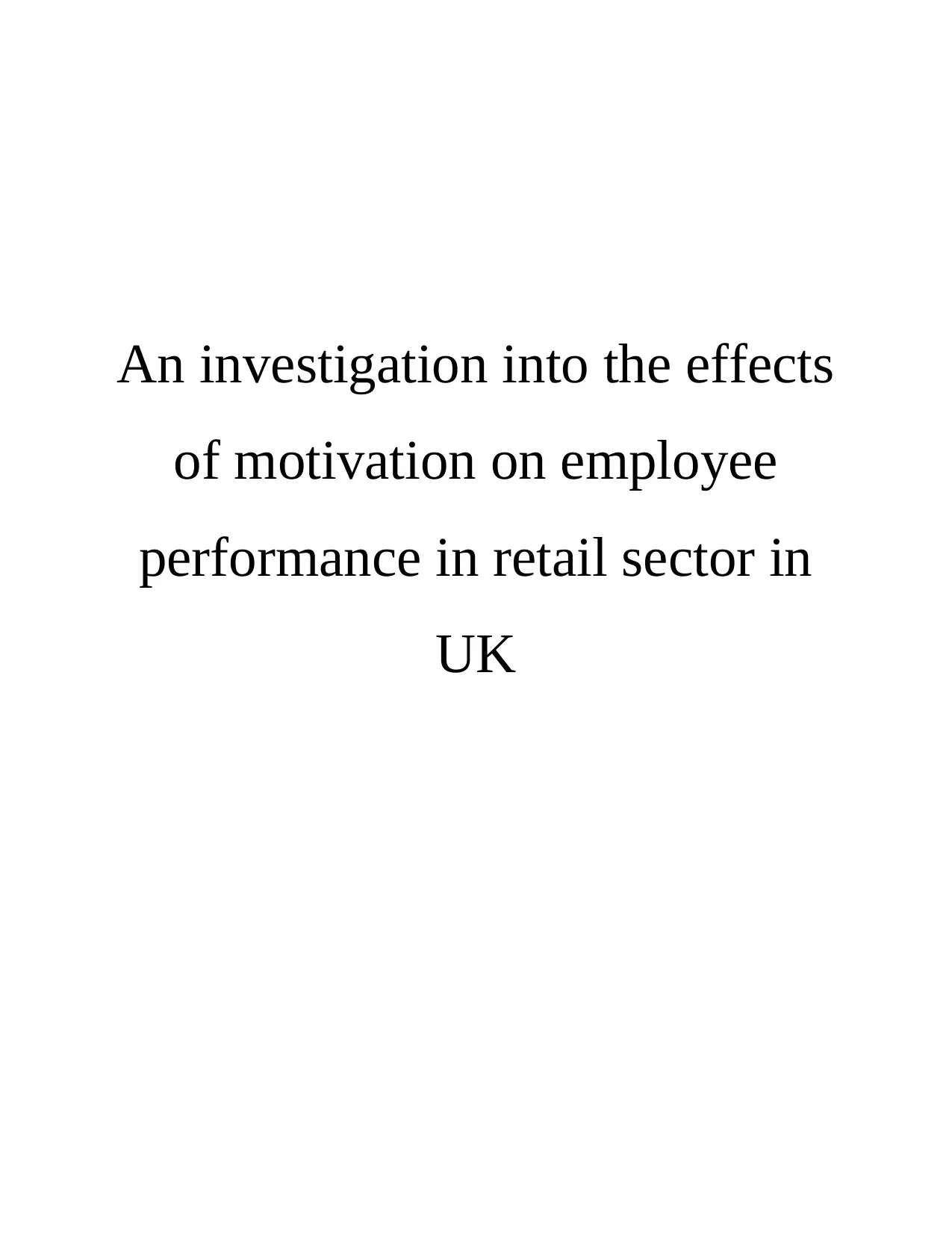
An investigation into the effects
of motivation on employee
performance in retail sector in
UK
of motivation on employee
performance in retail sector in
UK
Paraphrase This Document
Need a fresh take? Get an instant paraphrase of this document with our AI Paraphraser
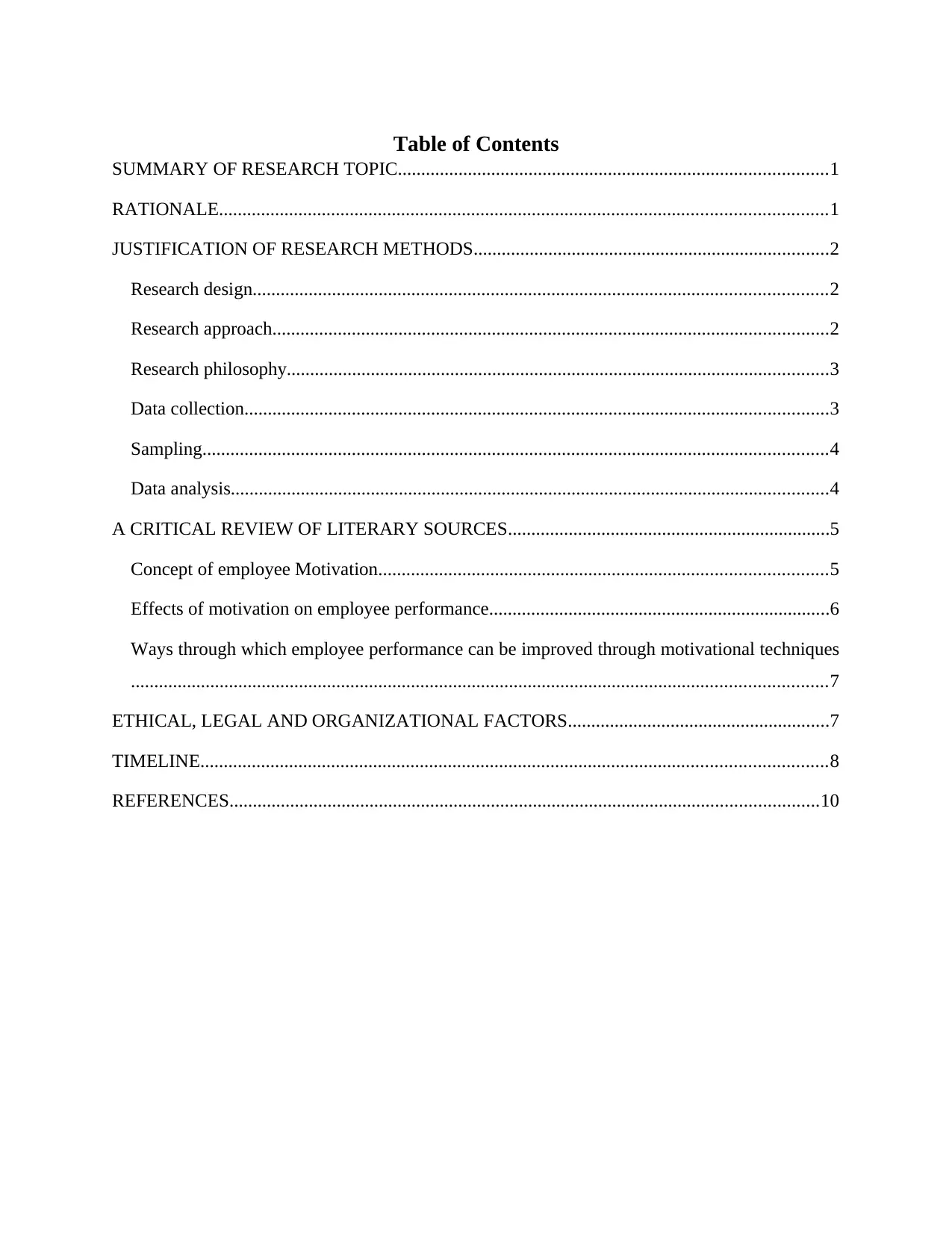
Table of Contents
SUMMARY OF RESEARCH TOPIC............................................................................................1
RATIONALE..................................................................................................................................1
JUSTIFICATION OF RESEARCH METHODS............................................................................2
Research design...........................................................................................................................2
Research approach.......................................................................................................................2
Research philosophy....................................................................................................................3
Data collection.............................................................................................................................3
Sampling......................................................................................................................................4
Data analysis................................................................................................................................4
A CRITICAL REVIEW OF LITERARY SOURCES.....................................................................5
Concept of employee Motivation................................................................................................5
Effects of motivation on employee performance.........................................................................6
Ways through which employee performance can be improved through motivational techniques
.....................................................................................................................................................7
ETHICAL, LEGAL AND ORGANIZATIONAL FACTORS........................................................7
TIMELINE......................................................................................................................................8
REFERENCES..............................................................................................................................10
SUMMARY OF RESEARCH TOPIC............................................................................................1
RATIONALE..................................................................................................................................1
JUSTIFICATION OF RESEARCH METHODS............................................................................2
Research design...........................................................................................................................2
Research approach.......................................................................................................................2
Research philosophy....................................................................................................................3
Data collection.............................................................................................................................3
Sampling......................................................................................................................................4
Data analysis................................................................................................................................4
A CRITICAL REVIEW OF LITERARY SOURCES.....................................................................5
Concept of employee Motivation................................................................................................5
Effects of motivation on employee performance.........................................................................6
Ways through which employee performance can be improved through motivational techniques
.....................................................................................................................................................7
ETHICAL, LEGAL AND ORGANIZATIONAL FACTORS........................................................7
TIMELINE......................................................................................................................................8
REFERENCES..............................................................................................................................10
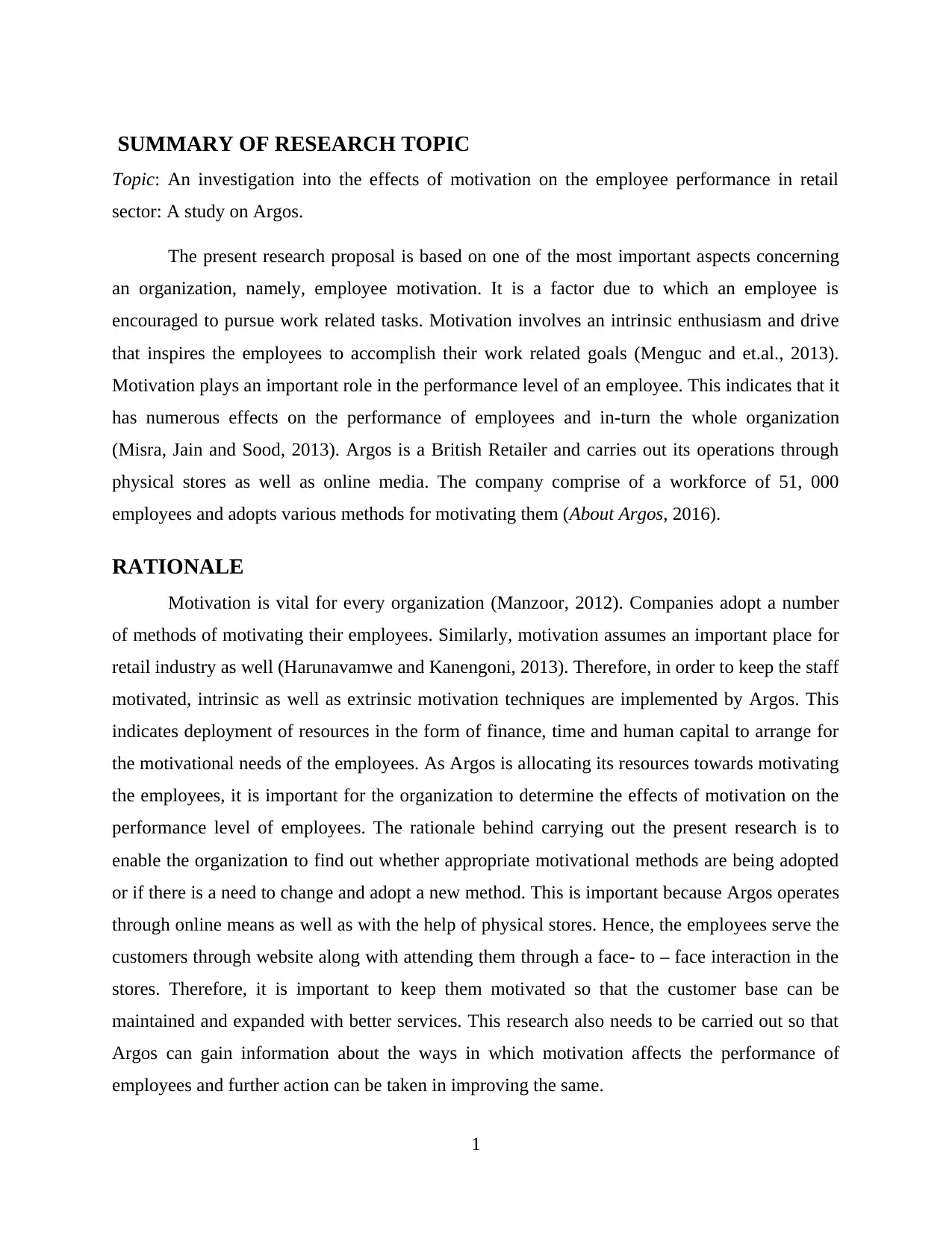
SUMMARY OF RESEARCH TOPIC
Topic: An investigation into the effects of motivation on the employee performance in retail
sector: A study on Argos.
The present research proposal is based on one of the most important aspects concerning
an organization, namely, employee motivation. It is a factor due to which an employee is
encouraged to pursue work related tasks. Motivation involves an intrinsic enthusiasm and drive
that inspires the employees to accomplish their work related goals (Menguc and et.al., 2013).
Motivation plays an important role in the performance level of an employee. This indicates that it
has numerous effects on the performance of employees and in-turn the whole organization
(Misra, Jain and Sood, 2013). Argos is a British Retailer and carries out its operations through
physical stores as well as online media. The company comprise of a workforce of 51, 000
employees and adopts various methods for motivating them (About Argos, 2016).
RATIONALE
Motivation is vital for every organization (Manzoor, 2012). Companies adopt a number
of methods of motivating their employees. Similarly, motivation assumes an important place for
retail industry as well (Harunavamwe and Kanengoni, 2013). Therefore, in order to keep the staff
motivated, intrinsic as well as extrinsic motivation techniques are implemented by Argos. This
indicates deployment of resources in the form of finance, time and human capital to arrange for
the motivational needs of the employees. As Argos is allocating its resources towards motivating
the employees, it is important for the organization to determine the effects of motivation on the
performance level of employees. The rationale behind carrying out the present research is to
enable the organization to find out whether appropriate motivational methods are being adopted
or if there is a need to change and adopt a new method. This is important because Argos operates
through online means as well as with the help of physical stores. Hence, the employees serve the
customers through website along with attending them through a face- to – face interaction in the
stores. Therefore, it is important to keep them motivated so that the customer base can be
maintained and expanded with better services. This research also needs to be carried out so that
Argos can gain information about the ways in which motivation affects the performance of
employees and further action can be taken in improving the same.
1
Topic: An investigation into the effects of motivation on the employee performance in retail
sector: A study on Argos.
The present research proposal is based on one of the most important aspects concerning
an organization, namely, employee motivation. It is a factor due to which an employee is
encouraged to pursue work related tasks. Motivation involves an intrinsic enthusiasm and drive
that inspires the employees to accomplish their work related goals (Menguc and et.al., 2013).
Motivation plays an important role in the performance level of an employee. This indicates that it
has numerous effects on the performance of employees and in-turn the whole organization
(Misra, Jain and Sood, 2013). Argos is a British Retailer and carries out its operations through
physical stores as well as online media. The company comprise of a workforce of 51, 000
employees and adopts various methods for motivating them (About Argos, 2016).
RATIONALE
Motivation is vital for every organization (Manzoor, 2012). Companies adopt a number
of methods of motivating their employees. Similarly, motivation assumes an important place for
retail industry as well (Harunavamwe and Kanengoni, 2013). Therefore, in order to keep the staff
motivated, intrinsic as well as extrinsic motivation techniques are implemented by Argos. This
indicates deployment of resources in the form of finance, time and human capital to arrange for
the motivational needs of the employees. As Argos is allocating its resources towards motivating
the employees, it is important for the organization to determine the effects of motivation on the
performance level of employees. The rationale behind carrying out the present research is to
enable the organization to find out whether appropriate motivational methods are being adopted
or if there is a need to change and adopt a new method. This is important because Argos operates
through online means as well as with the help of physical stores. Hence, the employees serve the
customers through website along with attending them through a face- to – face interaction in the
stores. Therefore, it is important to keep them motivated so that the customer base can be
maintained and expanded with better services. This research also needs to be carried out so that
Argos can gain information about the ways in which motivation affects the performance of
employees and further action can be taken in improving the same.
1
⊘ This is a preview!⊘
Do you want full access?
Subscribe today to unlock all pages.

Trusted by 1+ million students worldwide
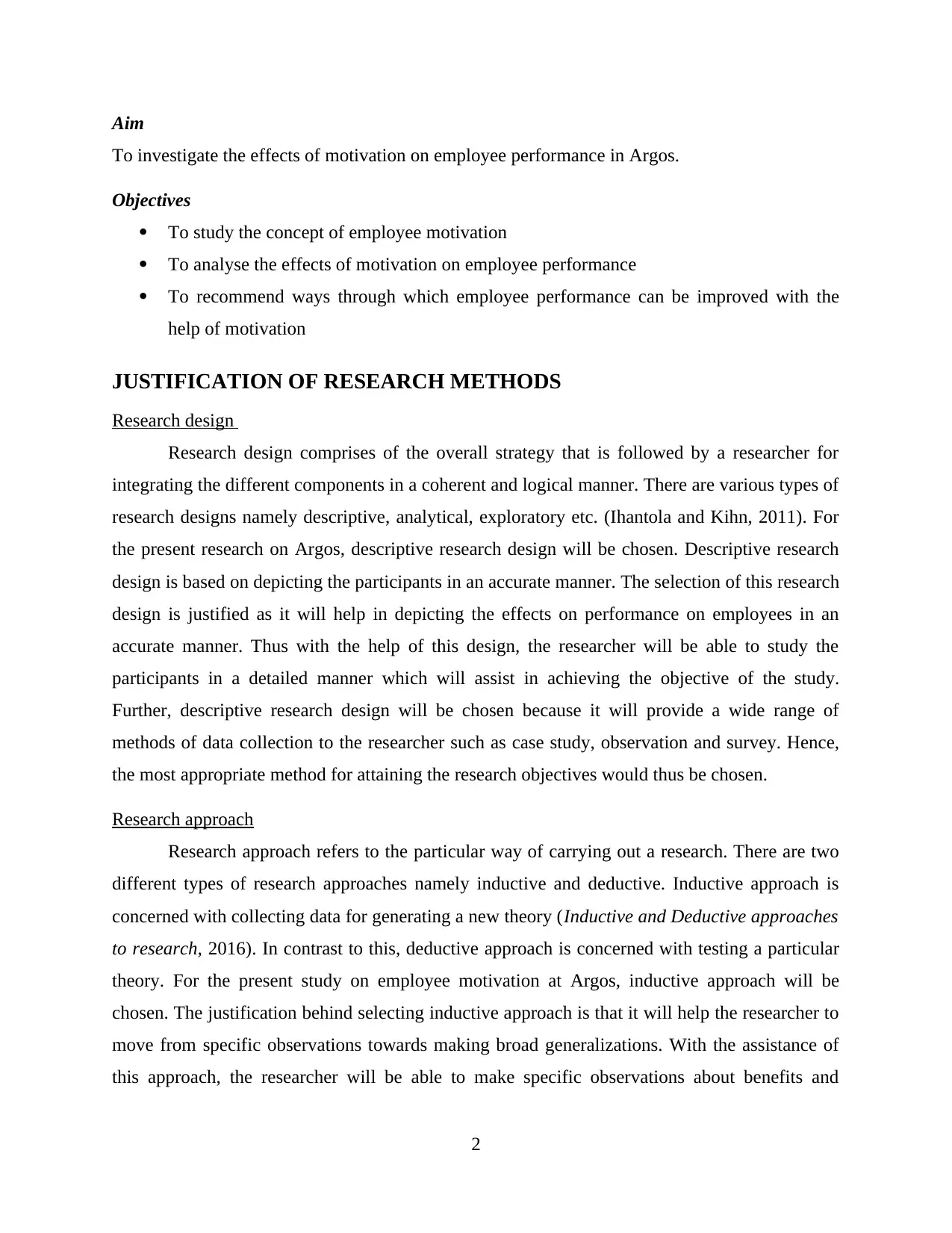
Aim
To investigate the effects of motivation on employee performance in Argos.
Objectives
To study the concept of employee motivation
To analyse the effects of motivation on employee performance
To recommend ways through which employee performance can be improved with the
help of motivation
JUSTIFICATION OF RESEARCH METHODS
Research design
Research design comprises of the overall strategy that is followed by a researcher for
integrating the different components in a coherent and logical manner. There are various types of
research designs namely descriptive, analytical, exploratory etc. (Ihantola and Kihn, 2011). For
the present research on Argos, descriptive research design will be chosen. Descriptive research
design is based on depicting the participants in an accurate manner. The selection of this research
design is justified as it will help in depicting the effects on performance on employees in an
accurate manner. Thus with the help of this design, the researcher will be able to study the
participants in a detailed manner which will assist in achieving the objective of the study.
Further, descriptive research design will be chosen because it will provide a wide range of
methods of data collection to the researcher such as case study, observation and survey. Hence,
the most appropriate method for attaining the research objectives would thus be chosen.
Research approach
Research approach refers to the particular way of carrying out a research. There are two
different types of research approaches namely inductive and deductive. Inductive approach is
concerned with collecting data for generating a new theory (Inductive and Deductive approaches
to research, 2016). In contrast to this, deductive approach is concerned with testing a particular
theory. For the present study on employee motivation at Argos, inductive approach will be
chosen. The justification behind selecting inductive approach is that it will help the researcher to
move from specific observations towards making broad generalizations. With the assistance of
this approach, the researcher will be able to make specific observations about benefits and
2
To investigate the effects of motivation on employee performance in Argos.
Objectives
To study the concept of employee motivation
To analyse the effects of motivation on employee performance
To recommend ways through which employee performance can be improved with the
help of motivation
JUSTIFICATION OF RESEARCH METHODS
Research design
Research design comprises of the overall strategy that is followed by a researcher for
integrating the different components in a coherent and logical manner. There are various types of
research designs namely descriptive, analytical, exploratory etc. (Ihantola and Kihn, 2011). For
the present research on Argos, descriptive research design will be chosen. Descriptive research
design is based on depicting the participants in an accurate manner. The selection of this research
design is justified as it will help in depicting the effects on performance on employees in an
accurate manner. Thus with the help of this design, the researcher will be able to study the
participants in a detailed manner which will assist in achieving the objective of the study.
Further, descriptive research design will be chosen because it will provide a wide range of
methods of data collection to the researcher such as case study, observation and survey. Hence,
the most appropriate method for attaining the research objectives would thus be chosen.
Research approach
Research approach refers to the particular way of carrying out a research. There are two
different types of research approaches namely inductive and deductive. Inductive approach is
concerned with collecting data for generating a new theory (Inductive and Deductive approaches
to research, 2016). In contrast to this, deductive approach is concerned with testing a particular
theory. For the present study on employee motivation at Argos, inductive approach will be
chosen. The justification behind selecting inductive approach is that it will help the researcher to
move from specific observations towards making broad generalizations. With the assistance of
this approach, the researcher will be able to make specific observations about benefits and
2
Paraphrase This Document
Need a fresh take? Get an instant paraphrase of this document with our AI Paraphraser
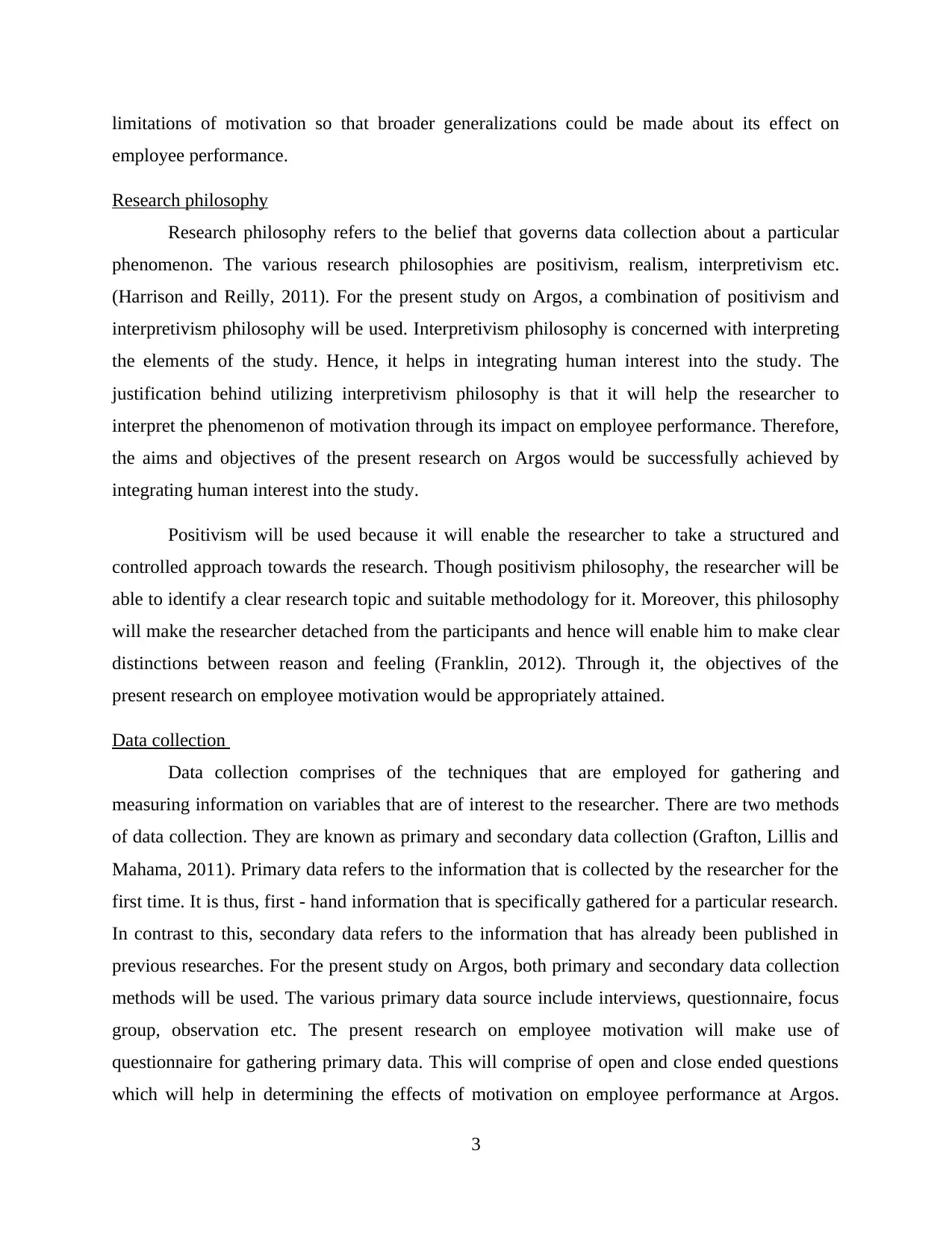
limitations of motivation so that broader generalizations could be made about its effect on
employee performance.
Research philosophy
Research philosophy refers to the belief that governs data collection about a particular
phenomenon. The various research philosophies are positivism, realism, interpretivism etc.
(Harrison and Reilly, 2011). For the present study on Argos, a combination of positivism and
interpretivism philosophy will be used. Interpretivism philosophy is concerned with interpreting
the elements of the study. Hence, it helps in integrating human interest into the study. The
justification behind utilizing interpretivism philosophy is that it will help the researcher to
interpret the phenomenon of motivation through its impact on employee performance. Therefore,
the aims and objectives of the present research on Argos would be successfully achieved by
integrating human interest into the study.
Positivism will be used because it will enable the researcher to take a structured and
controlled approach towards the research. Though positivism philosophy, the researcher will be
able to identify a clear research topic and suitable methodology for it. Moreover, this philosophy
will make the researcher detached from the participants and hence will enable him to make clear
distinctions between reason and feeling (Franklin, 2012). Through it, the objectives of the
present research on employee motivation would be appropriately attained.
Data collection
Data collection comprises of the techniques that are employed for gathering and
measuring information on variables that are of interest to the researcher. There are two methods
of data collection. They are known as primary and secondary data collection (Grafton, Lillis and
Mahama, 2011). Primary data refers to the information that is collected by the researcher for the
first time. It is thus, first - hand information that is specifically gathered for a particular research.
In contrast to this, secondary data refers to the information that has already been published in
previous researches. For the present study on Argos, both primary and secondary data collection
methods will be used. The various primary data source include interviews, questionnaire, focus
group, observation etc. The present research on employee motivation will make use of
questionnaire for gathering primary data. This will comprise of open and close ended questions
which will help in determining the effects of motivation on employee performance at Argos.
3
employee performance.
Research philosophy
Research philosophy refers to the belief that governs data collection about a particular
phenomenon. The various research philosophies are positivism, realism, interpretivism etc.
(Harrison and Reilly, 2011). For the present study on Argos, a combination of positivism and
interpretivism philosophy will be used. Interpretivism philosophy is concerned with interpreting
the elements of the study. Hence, it helps in integrating human interest into the study. The
justification behind utilizing interpretivism philosophy is that it will help the researcher to
interpret the phenomenon of motivation through its impact on employee performance. Therefore,
the aims and objectives of the present research on Argos would be successfully achieved by
integrating human interest into the study.
Positivism will be used because it will enable the researcher to take a structured and
controlled approach towards the research. Though positivism philosophy, the researcher will be
able to identify a clear research topic and suitable methodology for it. Moreover, this philosophy
will make the researcher detached from the participants and hence will enable him to make clear
distinctions between reason and feeling (Franklin, 2012). Through it, the objectives of the
present research on employee motivation would be appropriately attained.
Data collection
Data collection comprises of the techniques that are employed for gathering and
measuring information on variables that are of interest to the researcher. There are two methods
of data collection. They are known as primary and secondary data collection (Grafton, Lillis and
Mahama, 2011). Primary data refers to the information that is collected by the researcher for the
first time. It is thus, first - hand information that is specifically gathered for a particular research.
In contrast to this, secondary data refers to the information that has already been published in
previous researches. For the present study on Argos, both primary and secondary data collection
methods will be used. The various primary data source include interviews, questionnaire, focus
group, observation etc. The present research on employee motivation will make use of
questionnaire for gathering primary data. This will comprise of open and close ended questions
which will help in determining the effects of motivation on employee performance at Argos.
3
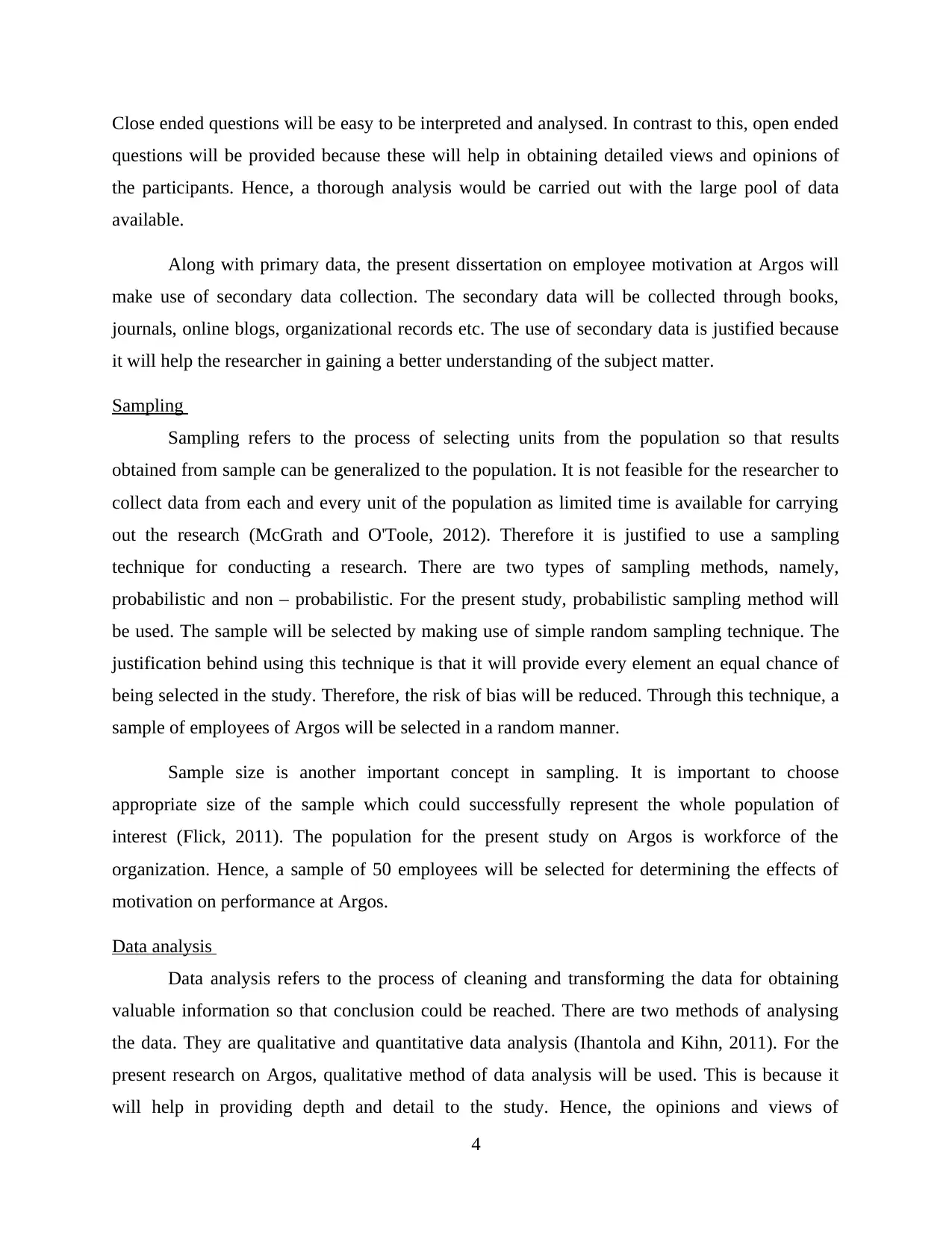
Close ended questions will be easy to be interpreted and analysed. In contrast to this, open ended
questions will be provided because these will help in obtaining detailed views and opinions of
the participants. Hence, a thorough analysis would be carried out with the large pool of data
available.
Along with primary data, the present dissertation on employee motivation at Argos will
make use of secondary data collection. The secondary data will be collected through books,
journals, online blogs, organizational records etc. The use of secondary data is justified because
it will help the researcher in gaining a better understanding of the subject matter.
Sampling
Sampling refers to the process of selecting units from the population so that results
obtained from sample can be generalized to the population. It is not feasible for the researcher to
collect data from each and every unit of the population as limited time is available for carrying
out the research (McGrath and O'Toole, 2012). Therefore it is justified to use a sampling
technique for conducting a research. There are two types of sampling methods, namely,
probabilistic and non – probabilistic. For the present study, probabilistic sampling method will
be used. The sample will be selected by making use of simple random sampling technique. The
justification behind using this technique is that it will provide every element an equal chance of
being selected in the study. Therefore, the risk of bias will be reduced. Through this technique, a
sample of employees of Argos will be selected in a random manner.
Sample size is another important concept in sampling. It is important to choose
appropriate size of the sample which could successfully represent the whole population of
interest (Flick, 2011). The population for the present study on Argos is workforce of the
organization. Hence, a sample of 50 employees will be selected for determining the effects of
motivation on performance at Argos.
Data analysis
Data analysis refers to the process of cleaning and transforming the data for obtaining
valuable information so that conclusion could be reached. There are two methods of analysing
the data. They are qualitative and quantitative data analysis (Ihantola and Kihn, 2011). For the
present research on Argos, qualitative method of data analysis will be used. This is because it
will help in providing depth and detail to the study. Hence, the opinions and views of
4
questions will be provided because these will help in obtaining detailed views and opinions of
the participants. Hence, a thorough analysis would be carried out with the large pool of data
available.
Along with primary data, the present dissertation on employee motivation at Argos will
make use of secondary data collection. The secondary data will be collected through books,
journals, online blogs, organizational records etc. The use of secondary data is justified because
it will help the researcher in gaining a better understanding of the subject matter.
Sampling
Sampling refers to the process of selecting units from the population so that results
obtained from sample can be generalized to the population. It is not feasible for the researcher to
collect data from each and every unit of the population as limited time is available for carrying
out the research (McGrath and O'Toole, 2012). Therefore it is justified to use a sampling
technique for conducting a research. There are two types of sampling methods, namely,
probabilistic and non – probabilistic. For the present study, probabilistic sampling method will
be used. The sample will be selected by making use of simple random sampling technique. The
justification behind using this technique is that it will provide every element an equal chance of
being selected in the study. Therefore, the risk of bias will be reduced. Through this technique, a
sample of employees of Argos will be selected in a random manner.
Sample size is another important concept in sampling. It is important to choose
appropriate size of the sample which could successfully represent the whole population of
interest (Flick, 2011). The population for the present study on Argos is workforce of the
organization. Hence, a sample of 50 employees will be selected for determining the effects of
motivation on performance at Argos.
Data analysis
Data analysis refers to the process of cleaning and transforming the data for obtaining
valuable information so that conclusion could be reached. There are two methods of analysing
the data. They are qualitative and quantitative data analysis (Ihantola and Kihn, 2011). For the
present research on Argos, qualitative method of data analysis will be used. This is because it
will help in providing depth and detail to the study. Hence, the opinions and views of
4
⊘ This is a preview!⊘
Do you want full access?
Subscribe today to unlock all pages.

Trusted by 1+ million students worldwide
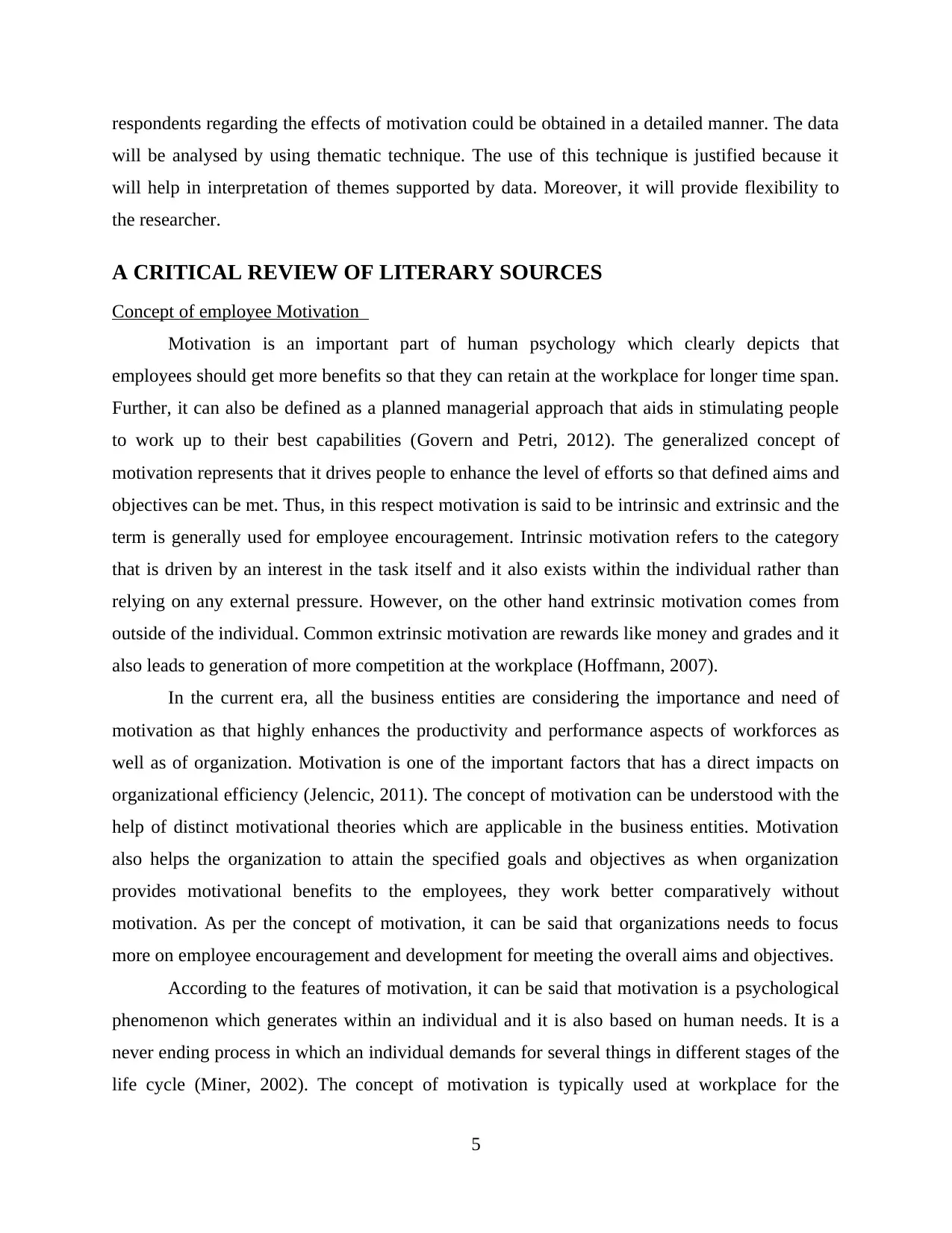
respondents regarding the effects of motivation could be obtained in a detailed manner. The data
will be analysed by using thematic technique. The use of this technique is justified because it
will help in interpretation of themes supported by data. Moreover, it will provide flexibility to
the researcher.
A CRITICAL REVIEW OF LITERARY SOURCES
Concept of employee Motivation
Motivation is an important part of human psychology which clearly depicts that
employees should get more benefits so that they can retain at the workplace for longer time span.
Further, it can also be defined as a planned managerial approach that aids in stimulating people
to work up to their best capabilities (Govern and Petri, 2012). The generalized concept of
motivation represents that it drives people to enhance the level of efforts so that defined aims and
objectives can be met. Thus, in this respect motivation is said to be intrinsic and extrinsic and the
term is generally used for employee encouragement. Intrinsic motivation refers to the category
that is driven by an interest in the task itself and it also exists within the individual rather than
relying on any external pressure. However, on the other hand extrinsic motivation comes from
outside of the individual. Common extrinsic motivation are rewards like money and grades and it
also leads to generation of more competition at the workplace (Hoffmann, 2007).
In the current era, all the business entities are considering the importance and need of
motivation as that highly enhances the productivity and performance aspects of workforces as
well as of organization. Motivation is one of the important factors that has a direct impacts on
organizational efficiency (Jelencic, 2011). The concept of motivation can be understood with the
help of distinct motivational theories which are applicable in the business entities. Motivation
also helps the organization to attain the specified goals and objectives as when organization
provides motivational benefits to the employees, they work better comparatively without
motivation. As per the concept of motivation, it can be said that organizations needs to focus
more on employee encouragement and development for meeting the overall aims and objectives.
According to the features of motivation, it can be said that motivation is a psychological
phenomenon which generates within an individual and it is also based on human needs. It is a
never ending process in which an individual demands for several things in different stages of the
life cycle (Miner, 2002). The concept of motivation is typically used at workplace for the
5
will be analysed by using thematic technique. The use of this technique is justified because it
will help in interpretation of themes supported by data. Moreover, it will provide flexibility to
the researcher.
A CRITICAL REVIEW OF LITERARY SOURCES
Concept of employee Motivation
Motivation is an important part of human psychology which clearly depicts that
employees should get more benefits so that they can retain at the workplace for longer time span.
Further, it can also be defined as a planned managerial approach that aids in stimulating people
to work up to their best capabilities (Govern and Petri, 2012). The generalized concept of
motivation represents that it drives people to enhance the level of efforts so that defined aims and
objectives can be met. Thus, in this respect motivation is said to be intrinsic and extrinsic and the
term is generally used for employee encouragement. Intrinsic motivation refers to the category
that is driven by an interest in the task itself and it also exists within the individual rather than
relying on any external pressure. However, on the other hand extrinsic motivation comes from
outside of the individual. Common extrinsic motivation are rewards like money and grades and it
also leads to generation of more competition at the workplace (Hoffmann, 2007).
In the current era, all the business entities are considering the importance and need of
motivation as that highly enhances the productivity and performance aspects of workforces as
well as of organization. Motivation is one of the important factors that has a direct impacts on
organizational efficiency (Jelencic, 2011). The concept of motivation can be understood with the
help of distinct motivational theories which are applicable in the business entities. Motivation
also helps the organization to attain the specified goals and objectives as when organization
provides motivational benefits to the employees, they work better comparatively without
motivation. As per the concept of motivation, it can be said that organizations needs to focus
more on employee encouragement and development for meeting the overall aims and objectives.
According to the features of motivation, it can be said that motivation is a psychological
phenomenon which generates within an individual and it is also based on human needs. It is a
never ending process in which an individual demands for several things in different stages of the
life cycle (Miner, 2002). The concept of motivation is typically used at workplace for the
5
Paraphrase This Document
Need a fresh take? Get an instant paraphrase of this document with our AI Paraphraser
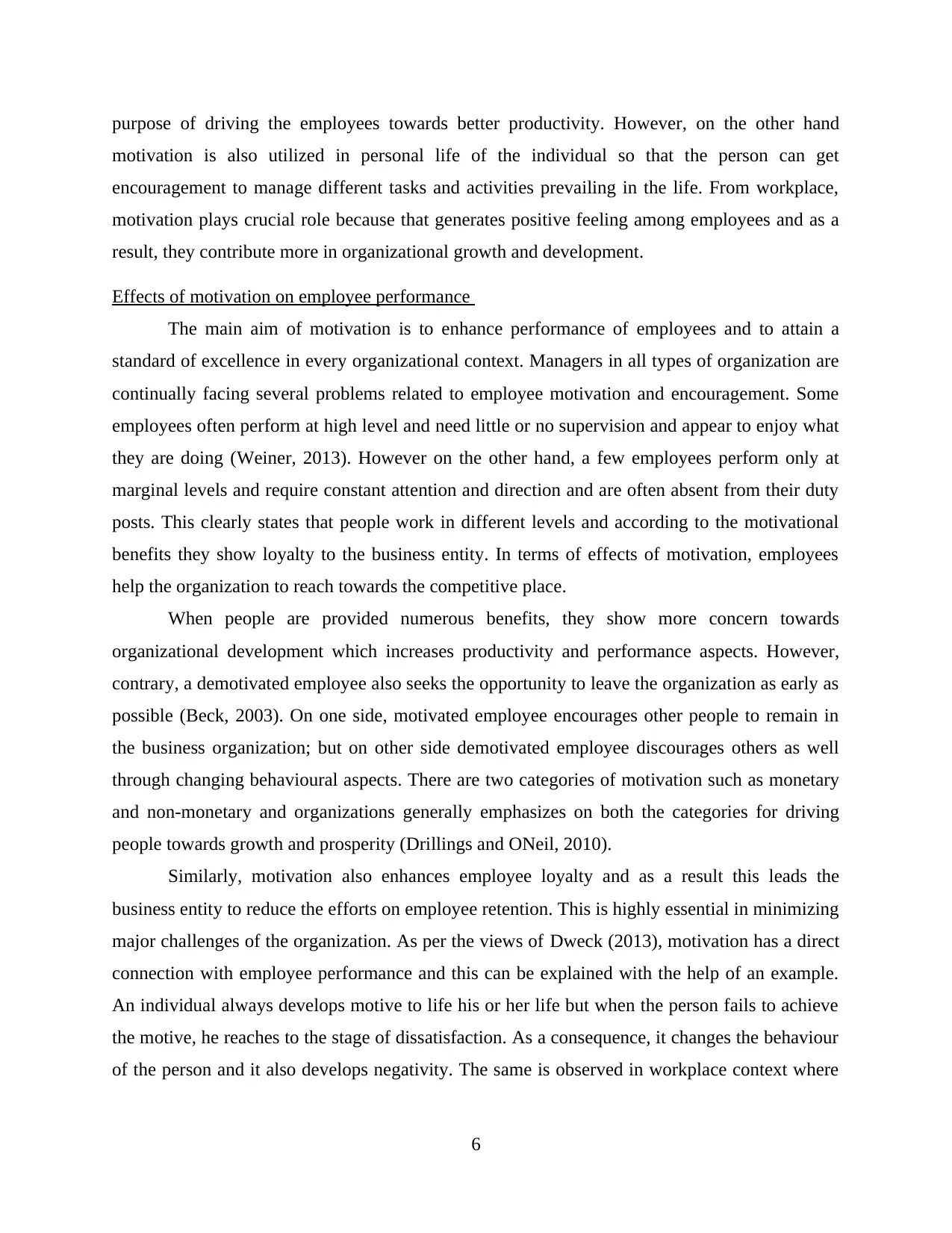
purpose of driving the employees towards better productivity. However, on the other hand
motivation is also utilized in personal life of the individual so that the person can get
encouragement to manage different tasks and activities prevailing in the life. From workplace,
motivation plays crucial role because that generates positive feeling among employees and as a
result, they contribute more in organizational growth and development.
Effects of motivation on employee performance
The main aim of motivation is to enhance performance of employees and to attain a
standard of excellence in every organizational context. Managers in all types of organization are
continually facing several problems related to employee motivation and encouragement. Some
employees often perform at high level and need little or no supervision and appear to enjoy what
they are doing (Weiner, 2013). However on the other hand, a few employees perform only at
marginal levels and require constant attention and direction and are often absent from their duty
posts. This clearly states that people work in different levels and according to the motivational
benefits they show loyalty to the business entity. In terms of effects of motivation, employees
help the organization to reach towards the competitive place.
When people are provided numerous benefits, they show more concern towards
organizational development which increases productivity and performance aspects. However,
contrary, a demotivated employee also seeks the opportunity to leave the organization as early as
possible (Beck, 2003). On one side, motivated employee encourages other people to remain in
the business organization; but on other side demotivated employee discourages others as well
through changing behavioural aspects. There are two categories of motivation such as monetary
and non-monetary and organizations generally emphasizes on both the categories for driving
people towards growth and prosperity (Drillings and ONeil, 2010).
Similarly, motivation also enhances employee loyalty and as a result this leads the
business entity to reduce the efforts on employee retention. This is highly essential in minimizing
major challenges of the organization. As per the views of Dweck (2013), motivation has a direct
connection with employee performance and this can be explained with the help of an example.
An individual always develops motive to life his or her life but when the person fails to achieve
the motive, he reaches to the stage of dissatisfaction. As a consequence, it changes the behaviour
of the person and it also develops negativity. The same is observed in workplace context where
6
motivation is also utilized in personal life of the individual so that the person can get
encouragement to manage different tasks and activities prevailing in the life. From workplace,
motivation plays crucial role because that generates positive feeling among employees and as a
result, they contribute more in organizational growth and development.
Effects of motivation on employee performance
The main aim of motivation is to enhance performance of employees and to attain a
standard of excellence in every organizational context. Managers in all types of organization are
continually facing several problems related to employee motivation and encouragement. Some
employees often perform at high level and need little or no supervision and appear to enjoy what
they are doing (Weiner, 2013). However on the other hand, a few employees perform only at
marginal levels and require constant attention and direction and are often absent from their duty
posts. This clearly states that people work in different levels and according to the motivational
benefits they show loyalty to the business entity. In terms of effects of motivation, employees
help the organization to reach towards the competitive place.
When people are provided numerous benefits, they show more concern towards
organizational development which increases productivity and performance aspects. However,
contrary, a demotivated employee also seeks the opportunity to leave the organization as early as
possible (Beck, 2003). On one side, motivated employee encourages other people to remain in
the business organization; but on other side demotivated employee discourages others as well
through changing behavioural aspects. There are two categories of motivation such as monetary
and non-monetary and organizations generally emphasizes on both the categories for driving
people towards growth and prosperity (Drillings and ONeil, 2010).
Similarly, motivation also enhances employee loyalty and as a result this leads the
business entity to reduce the efforts on employee retention. This is highly essential in minimizing
major challenges of the organization. As per the views of Dweck (2013), motivation has a direct
connection with employee performance and this can be explained with the help of an example.
An individual always develops motive to life his or her life but when the person fails to achieve
the motive, he reaches to the stage of dissatisfaction. As a consequence, it changes the behaviour
of the person and it also develops negativity. The same is observed in workplace context where
6
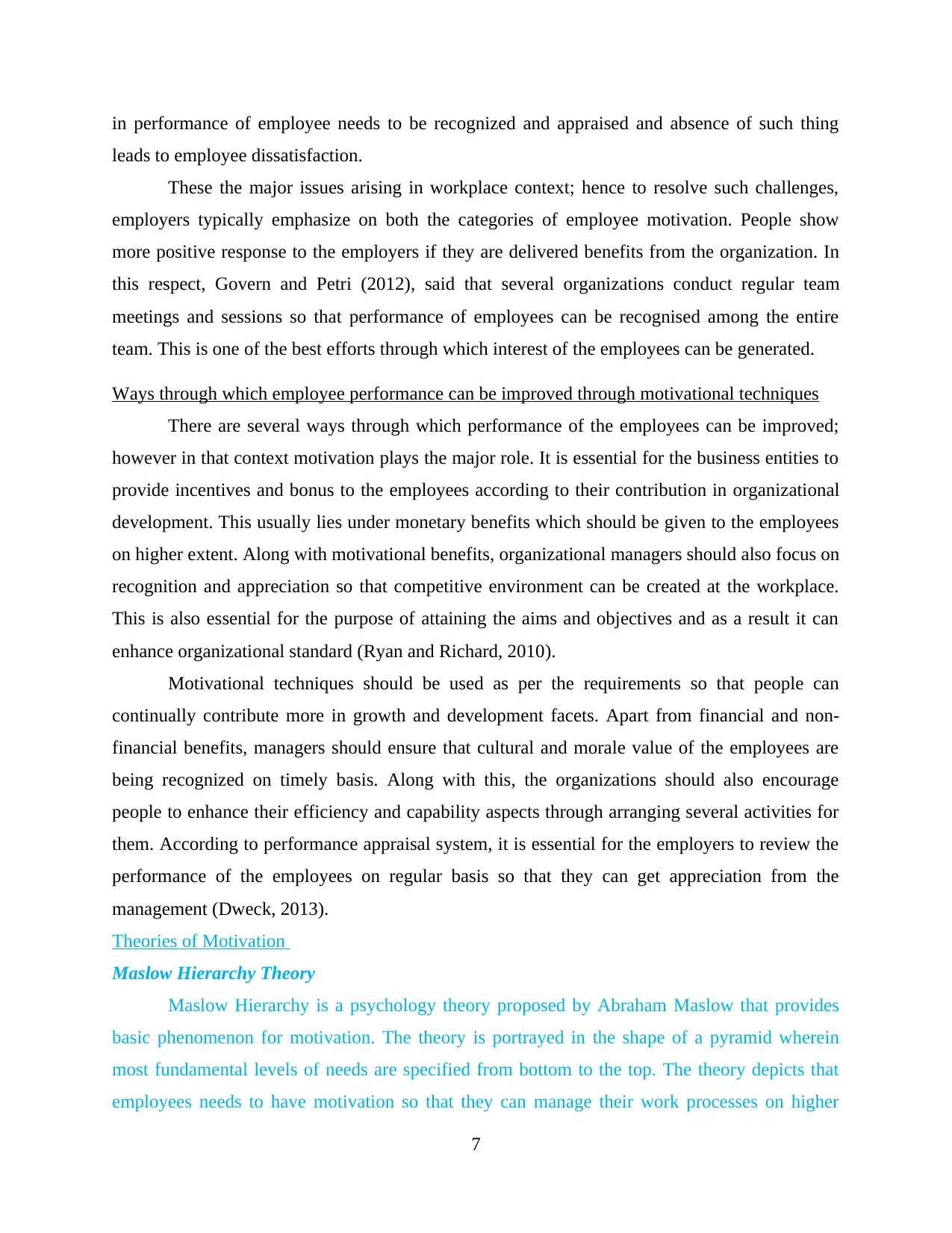
in performance of employee needs to be recognized and appraised and absence of such thing
leads to employee dissatisfaction.
These the major issues arising in workplace context; hence to resolve such challenges,
employers typically emphasize on both the categories of employee motivation. People show
more positive response to the employers if they are delivered benefits from the organization. In
this respect, Govern and Petri (2012), said that several organizations conduct regular team
meetings and sessions so that performance of employees can be recognised among the entire
team. This is one of the best efforts through which interest of the employees can be generated.
Ways through which employee performance can be improved through motivational techniques
There are several ways through which performance of the employees can be improved;
however in that context motivation plays the major role. It is essential for the business entities to
provide incentives and bonus to the employees according to their contribution in organizational
development. This usually lies under monetary benefits which should be given to the employees
on higher extent. Along with motivational benefits, organizational managers should also focus on
recognition and appreciation so that competitive environment can be created at the workplace.
This is also essential for the purpose of attaining the aims and objectives and as a result it can
enhance organizational standard (Ryan and Richard, 2010).
Motivational techniques should be used as per the requirements so that people can
continually contribute more in growth and development facets. Apart from financial and non-
financial benefits, managers should ensure that cultural and morale value of the employees are
being recognized on timely basis. Along with this, the organizations should also encourage
people to enhance their efficiency and capability aspects through arranging several activities for
them. According to performance appraisal system, it is essential for the employers to review the
performance of the employees on regular basis so that they can get appreciation from the
management (Dweck, 2013).
Theories of Motivation
Maslow Hierarchy Theory
Maslow Hierarchy is a psychology theory proposed by Abraham Maslow that provides
basic phenomenon for motivation. The theory is portrayed in the shape of a pyramid wherein
most fundamental levels of needs are specified from bottom to the top. The theory depicts that
employees needs to have motivation so that they can manage their work processes on higher
7
leads to employee dissatisfaction.
These the major issues arising in workplace context; hence to resolve such challenges,
employers typically emphasize on both the categories of employee motivation. People show
more positive response to the employers if they are delivered benefits from the organization. In
this respect, Govern and Petri (2012), said that several organizations conduct regular team
meetings and sessions so that performance of employees can be recognised among the entire
team. This is one of the best efforts through which interest of the employees can be generated.
Ways through which employee performance can be improved through motivational techniques
There are several ways through which performance of the employees can be improved;
however in that context motivation plays the major role. It is essential for the business entities to
provide incentives and bonus to the employees according to their contribution in organizational
development. This usually lies under monetary benefits which should be given to the employees
on higher extent. Along with motivational benefits, organizational managers should also focus on
recognition and appreciation so that competitive environment can be created at the workplace.
This is also essential for the purpose of attaining the aims and objectives and as a result it can
enhance organizational standard (Ryan and Richard, 2010).
Motivational techniques should be used as per the requirements so that people can
continually contribute more in growth and development facets. Apart from financial and non-
financial benefits, managers should ensure that cultural and morale value of the employees are
being recognized on timely basis. Along with this, the organizations should also encourage
people to enhance their efficiency and capability aspects through arranging several activities for
them. According to performance appraisal system, it is essential for the employers to review the
performance of the employees on regular basis so that they can get appreciation from the
management (Dweck, 2013).
Theories of Motivation
Maslow Hierarchy Theory
Maslow Hierarchy is a psychology theory proposed by Abraham Maslow that provides
basic phenomenon for motivation. The theory is portrayed in the shape of a pyramid wherein
most fundamental levels of needs are specified from bottom to the top. The theory depicts that
employees needs to have motivation so that they can manage their work processes on higher
7
⊘ This is a preview!⊘
Do you want full access?
Subscribe today to unlock all pages.

Trusted by 1+ million students worldwide
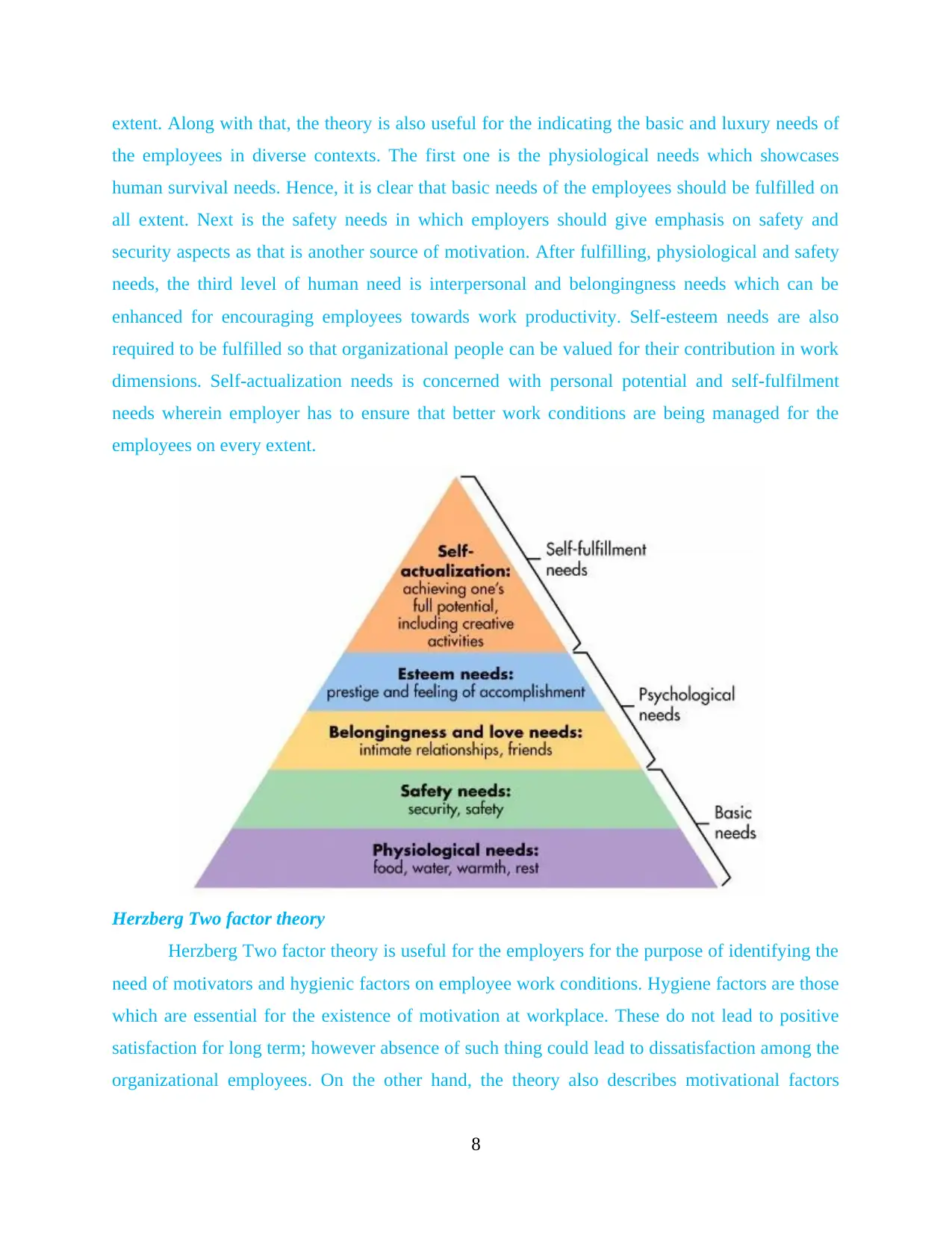
extent. Along with that, the theory is also useful for the indicating the basic and luxury needs of
the employees in diverse contexts. The first one is the physiological needs which showcases
human survival needs. Hence, it is clear that basic needs of the employees should be fulfilled on
all extent. Next is the safety needs in which employers should give emphasis on safety and
security aspects as that is another source of motivation. After fulfilling, physiological and safety
needs, the third level of human need is interpersonal and belongingness needs which can be
enhanced for encouraging employees towards work productivity. Self-esteem needs are also
required to be fulfilled so that organizational people can be valued for their contribution in work
dimensions. Self-actualization needs is concerned with personal potential and self-fulfilment
needs wherein employer has to ensure that better work conditions are being managed for the
employees on every extent.
Herzberg Two factor theory
Herzberg Two factor theory is useful for the employers for the purpose of identifying the
need of motivators and hygienic factors on employee work conditions. Hygiene factors are those
which are essential for the existence of motivation at workplace. These do not lead to positive
satisfaction for long term; however absence of such thing could lead to dissatisfaction among the
organizational employees. On the other hand, the theory also describes motivational factors
8
the employees in diverse contexts. The first one is the physiological needs which showcases
human survival needs. Hence, it is clear that basic needs of the employees should be fulfilled on
all extent. Next is the safety needs in which employers should give emphasis on safety and
security aspects as that is another source of motivation. After fulfilling, physiological and safety
needs, the third level of human need is interpersonal and belongingness needs which can be
enhanced for encouraging employees towards work productivity. Self-esteem needs are also
required to be fulfilled so that organizational people can be valued for their contribution in work
dimensions. Self-actualization needs is concerned with personal potential and self-fulfilment
needs wherein employer has to ensure that better work conditions are being managed for the
employees on every extent.
Herzberg Two factor theory
Herzberg Two factor theory is useful for the employers for the purpose of identifying the
need of motivators and hygienic factors on employee work conditions. Hygiene factors are those
which are essential for the existence of motivation at workplace. These do not lead to positive
satisfaction for long term; however absence of such thing could lead to dissatisfaction among the
organizational employees. On the other hand, the theory also describes motivational factors
8
Paraphrase This Document
Need a fresh take? Get an instant paraphrase of this document with our AI Paraphraser
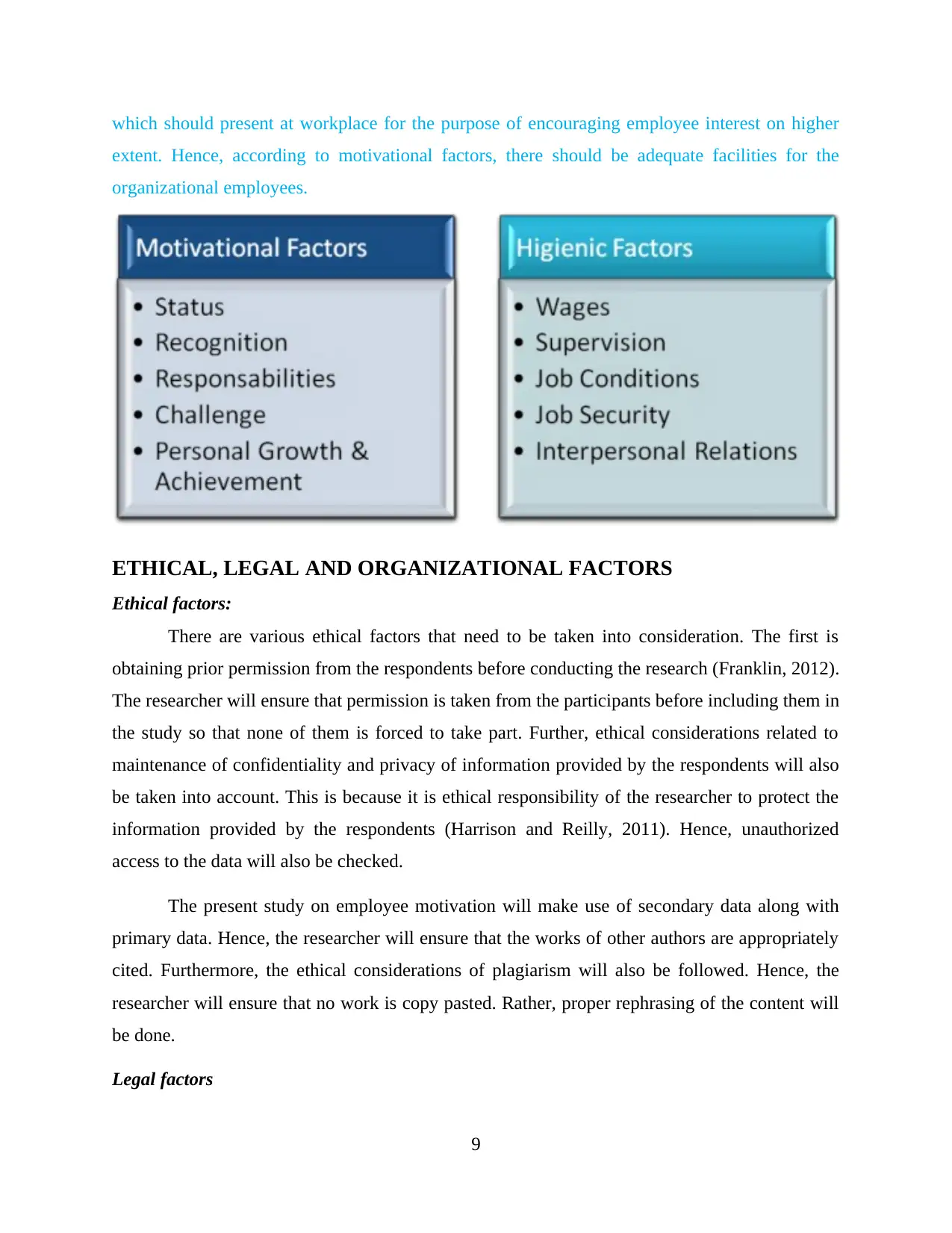
which should present at workplace for the purpose of encouraging employee interest on higher
extent. Hence, according to motivational factors, there should be adequate facilities for the
organizational employees.
ETHICAL, LEGAL AND ORGANIZATIONAL FACTORS
Ethical factors:
There are various ethical factors that need to be taken into consideration. The first is
obtaining prior permission from the respondents before conducting the research (Franklin, 2012).
The researcher will ensure that permission is taken from the participants before including them in
the study so that none of them is forced to take part. Further, ethical considerations related to
maintenance of confidentiality and privacy of information provided by the respondents will also
be taken into account. This is because it is ethical responsibility of the researcher to protect the
information provided by the respondents (Harrison and Reilly, 2011). Hence, unauthorized
access to the data will also be checked.
The present study on employee motivation will make use of secondary data along with
primary data. Hence, the researcher will ensure that the works of other authors are appropriately
cited. Furthermore, the ethical considerations of plagiarism will also be followed. Hence, the
researcher will ensure that no work is copy pasted. Rather, proper rephrasing of the content will
be done.
Legal factors
9
extent. Hence, according to motivational factors, there should be adequate facilities for the
organizational employees.
ETHICAL, LEGAL AND ORGANIZATIONAL FACTORS
Ethical factors:
There are various ethical factors that need to be taken into consideration. The first is
obtaining prior permission from the respondents before conducting the research (Franklin, 2012).
The researcher will ensure that permission is taken from the participants before including them in
the study so that none of them is forced to take part. Further, ethical considerations related to
maintenance of confidentiality and privacy of information provided by the respondents will also
be taken into account. This is because it is ethical responsibility of the researcher to protect the
information provided by the respondents (Harrison and Reilly, 2011). Hence, unauthorized
access to the data will also be checked.
The present study on employee motivation will make use of secondary data along with
primary data. Hence, the researcher will ensure that the works of other authors are appropriately
cited. Furthermore, the ethical considerations of plagiarism will also be followed. Hence, the
researcher will ensure that no work is copy pasted. Rather, proper rephrasing of the content will
be done.
Legal factors
9
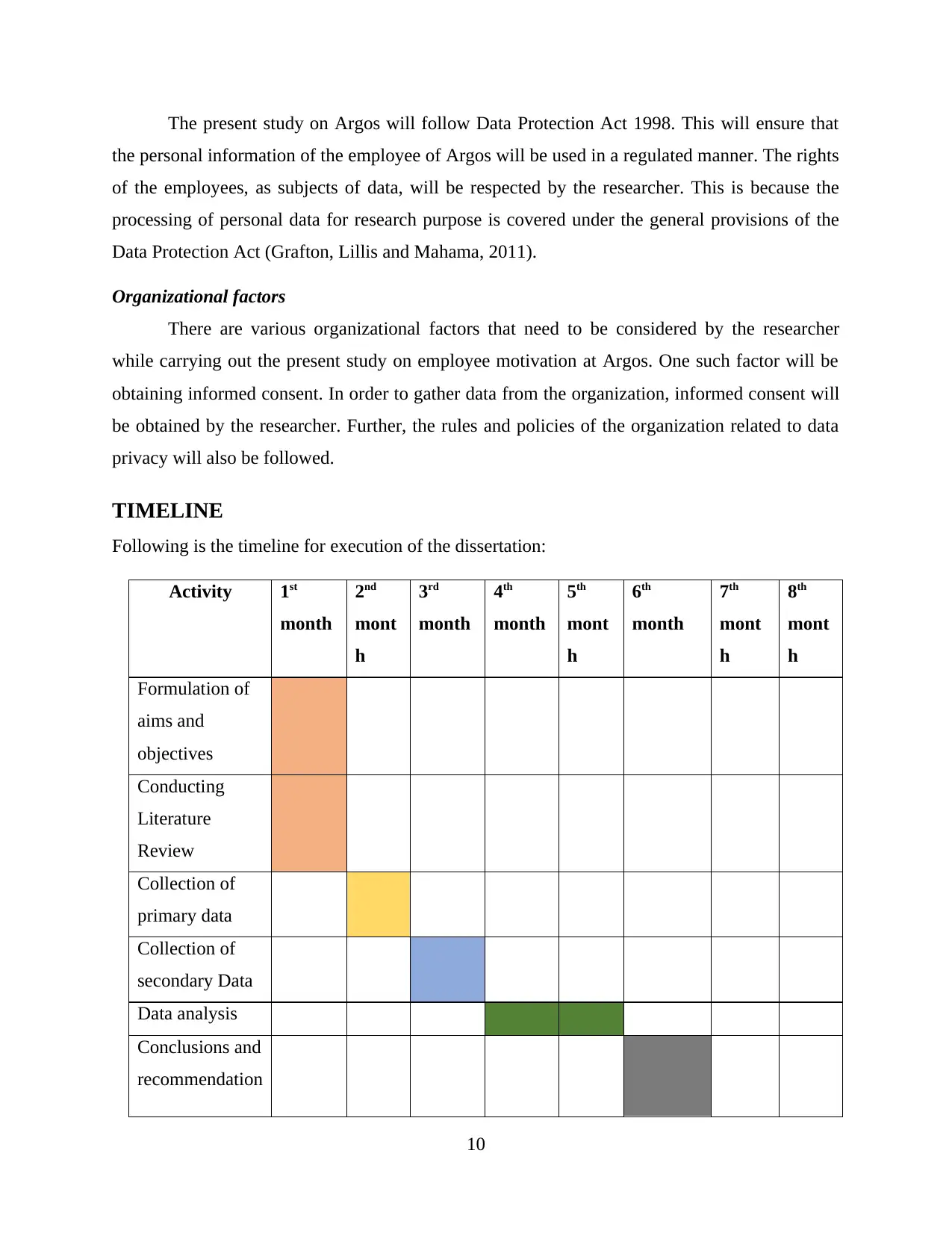
The present study on Argos will follow Data Protection Act 1998. This will ensure that
the personal information of the employee of Argos will be used in a regulated manner. The rights
of the employees, as subjects of data, will be respected by the researcher. This is because the
processing of personal data for research purpose is covered under the general provisions of the
Data Protection Act (Grafton, Lillis and Mahama, 2011).
Organizational factors
There are various organizational factors that need to be considered by the researcher
while carrying out the present study on employee motivation at Argos. One such factor will be
obtaining informed consent. In order to gather data from the organization, informed consent will
be obtained by the researcher. Further, the rules and policies of the organization related to data
privacy will also be followed.
TIMELINE
Following is the timeline for execution of the dissertation:
Activity 1st
month
2nd
mont
h
3rd
month
4th
month
5th
mont
h
6th
month
7th
mont
h
8th
mont
h
Formulation of
aims and
objectives
Conducting
Literature
Review
Collection of
primary data
Collection of
secondary Data
Data analysis
Conclusions and
recommendation
10
the personal information of the employee of Argos will be used in a regulated manner. The rights
of the employees, as subjects of data, will be respected by the researcher. This is because the
processing of personal data for research purpose is covered under the general provisions of the
Data Protection Act (Grafton, Lillis and Mahama, 2011).
Organizational factors
There are various organizational factors that need to be considered by the researcher
while carrying out the present study on employee motivation at Argos. One such factor will be
obtaining informed consent. In order to gather data from the organization, informed consent will
be obtained by the researcher. Further, the rules and policies of the organization related to data
privacy will also be followed.
TIMELINE
Following is the timeline for execution of the dissertation:
Activity 1st
month
2nd
mont
h
3rd
month
4th
month
5th
mont
h
6th
month
7th
mont
h
8th
mont
h
Formulation of
aims and
objectives
Conducting
Literature
Review
Collection of
primary data
Collection of
secondary Data
Data analysis
Conclusions and
recommendation
10
⊘ This is a preview!⊘
Do you want full access?
Subscribe today to unlock all pages.

Trusted by 1+ million students worldwide
1 out of 15
Related Documents
Your All-in-One AI-Powered Toolkit for Academic Success.
+13062052269
info@desklib.com
Available 24*7 on WhatsApp / Email
![[object Object]](/_next/static/media/star-bottom.7253800d.svg)
Unlock your academic potential
Copyright © 2020–2025 A2Z Services. All Rights Reserved. Developed and managed by ZUCOL.





